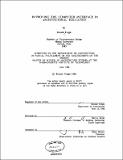| dc.contributor.advisor | Harvey Bryan. | en_US |
| dc.contributor.author | Fergle, Ronald | en_US |
| dc.contributor.other | Massachusetts Institute of Technology. Department of Architecture. | en_US |
| dc.date.accessioned | 2013-08-22T18:40:47Z | |
| dc.date.available | 2013-08-22T18:40:47Z | |
| dc.date.copyright | 1986 | en_US |
| dc.date.issued | 1986 | en_US |
| dc.identifier.uri | http://hdl.handle.net/1721.1/79944 | |
| dc.description | Thesis (M.S.)--Massachusetts Institute of Technology, Dept. of Architecture, 1986. | en_US |
| dc.description | MICROFICHE COPY AVAILABLE IN ARCHIVES AND ROTCH | en_US |
| dc.description | Includes bibliographical references (leaves 73-74). | en_US |
| dc.description.abstract | The influence of the computer is increasing within the architectural profession. One aspect of this is the growing use of microcomputer programs in architectural education. Many of these programs have their roots in the engineering disciplines, and therefore their procedural methodology may no t be compatible with the architectural design process. In addition to this, most of the programs used in the universities are originally designed for the professional practitioner, and may not be appropriate for the academic environment This discussion explores the characteristics of the architectural design process, and what issues programmers need to address when writing software for use by designers. More specifically, how should the programmer approach designing educational software, so that the computer becomes a more effective tool in enabling the student to develop heuristic knowledge about some aspect of architectural design. The programming factors that influence the effectiveness of this type of educational software include: the appropriate use of graphics, flexible input/output sequences, procedural transparency of the program structure, and the iterative comparison of design options. These concepts are analyzed in a series of programming examples involving energy analysis and daylighting analysis. Existing programs are critiqued, and suggestions for improvements are made. The use of processors to facilitate the testing and comparison of results are presented, as well as guidelines for additional developments using knowledge base overlays. | en_US |
| dc.description.statementofresponsibility | by Ronald Fergle. | en_US |
| dc.format.extent | 76 leaves | en_US |
| dc.language.iso | eng | en_US |
| dc.publisher | Massachusetts Institute of Technology | en_US |
| dc.rights | M.I.T. theses are protected by
copyright. They may be viewed from this source for any purpose, but
reproduction or distribution in any format is prohibited without written
permission. See provided URL for inquiries about permission. | en_US |
| dc.rights.uri | http://dspace.mit.edu/handle/1721.1/7582 | en_US |
| dc.subject | Architecture. | en_US |
| dc.title | Improving the computer interface in architectural education | en_US |
| dc.title.alternative | Architectural education, Improving the computer interface in | en_US |
| dc.type | Thesis | en_US |
| dc.description.degree | M.S. | en_US |
| dc.contributor.department | Massachusetts Institute of Technology. Department of Architecture | |
| dc.identifier.oclc | 15466773 | en_US |
